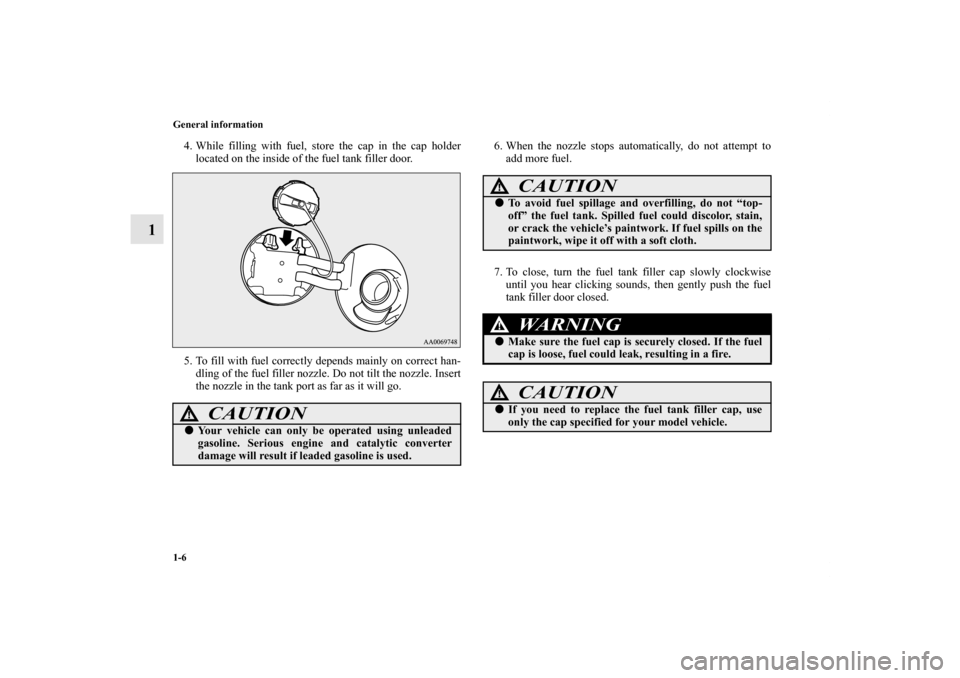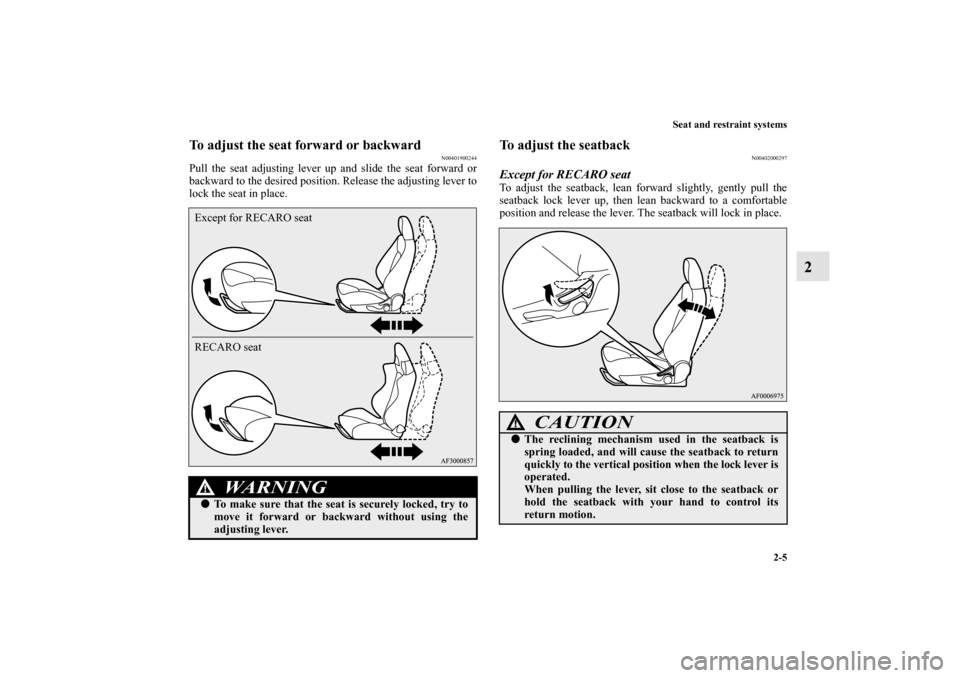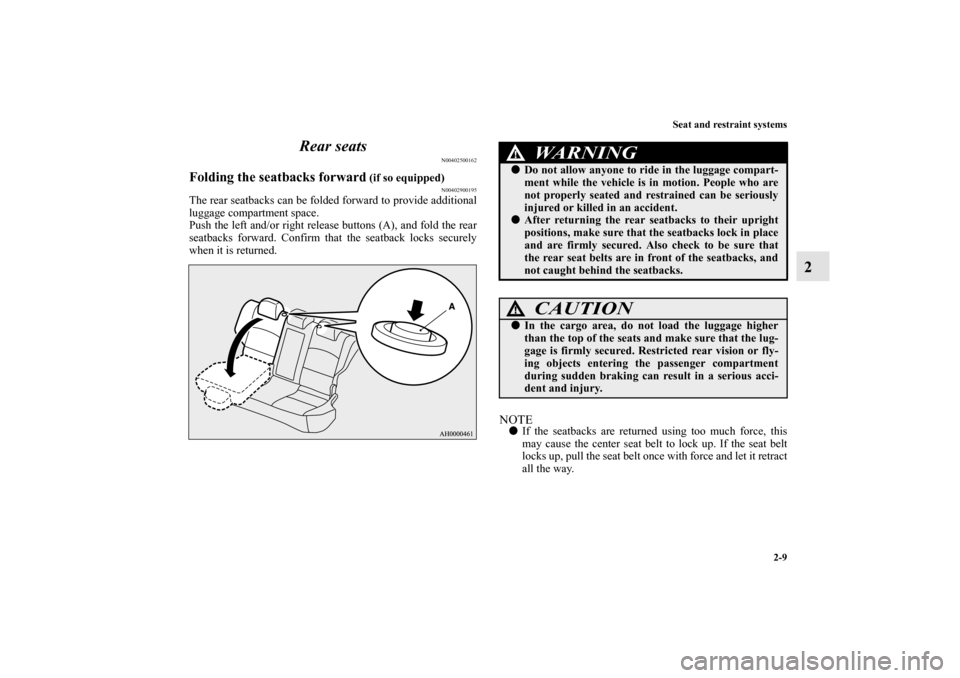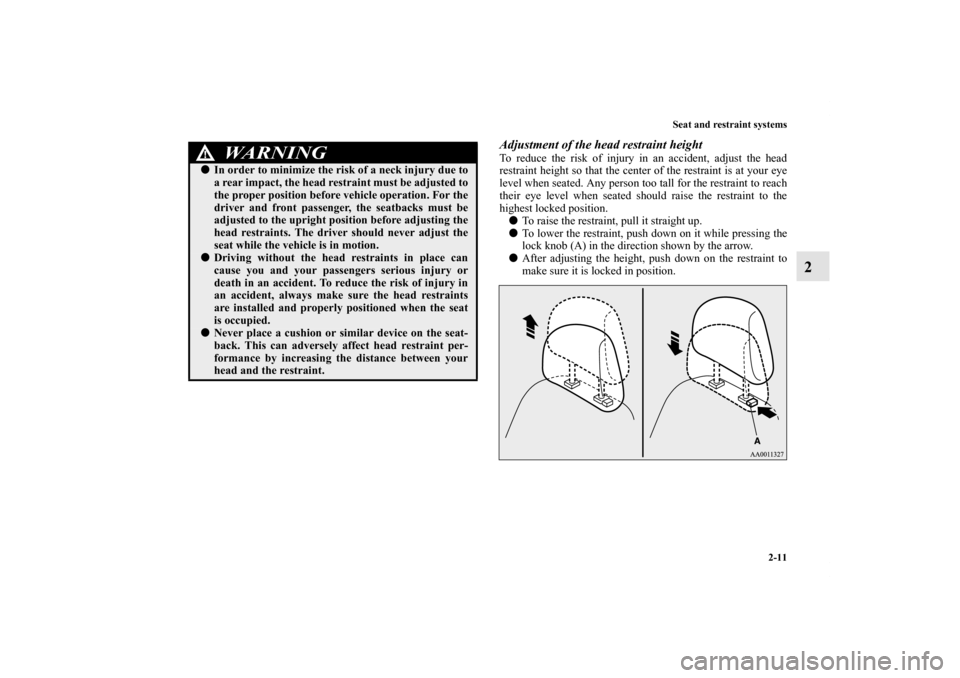Page 20 of 722

Quick index
5
Problem
Do this
Ref. page
The engine coolant temperature
display “ ” in the multi-informa-
tion display is flashing.
Steam comes out of the engine
compartment.
Ty p e 1
Ty p e 2The engine is overheated.
Carefully stop the vehicle in a safe place.P. 6 - 5
If your vehicle becomes stuck in
sand, mud or snow1. Slowly press down on the accelerator pedal to get your vehicle moving again.
For vehicle equipped with the Electronically controlled 4WD system, set the
drive mode-selector to the “4WD AUTO” or “4WD LOCK” position and then
slowly press down on the accelerator pedal to get your vehicle moving.
2. If there is nothing to stop your tires from slipping, rock your vehicle back and
forth to free it.P.6-24
WA R N I N G
!�When attempting to rock your vehicle out of a stuck position, be sure that no one is near the vehicle. The rocking
motion may cause the vehicle to suddenly lurch forward or backward, possibly injuring bystanders.
BK0150800US.book 5 ページ 2012年3月29日 木曜日 午後2時38分
Page 28 of 722
General information
1-5
1
Fuel tank capacityFront-wheel drive vehicles: 15.5 gal (59.0 L)
All-wheel drive vehicles: 14.5 gal (55.0 L)Refueling1. Before filling with fuel, stop the engine.
2. The fuel tank filler is located on the rear driver side of
your vehicle.
The fuel tank filler door can be opened from inside the
vehicle with the fuel tank filler door release lever located
at the left side of the driver’s seat.3. Open the fuel tank filler pipe by slowly turning the cap
counterclockwise.
A- Remove
B- Close
WA R N I N G
!�Since the fuel system may be under pressure,
remove the fuel tank filler cap slowly. This relieves
any pressure or vacuum that might have built up in
the fuel tank. If the cap is venting vapor or if you
hear a hissing sound, wait until it stops before
removing the cap. Otherwise, fuel may spray out,
injuring you or others.
BK0150800US.book 5 ページ 2012年3月29日 木曜日 午後2時38分
Page 29 of 722

1-6 General information
1
4. While filling with fuel, store the cap in the cap holder
located on the inside of the fuel tank filler door.
5. To fill with fuel correctly depends mainly on correct han-
dling of the fuel filler nozzle. Do not tilt the nozzle. Insert
the nozzle in the tank port as far as it will go.6. When the nozzle stops automatically, do not attempt to
add more fuel.
7. To close, turn the fuel tank filler cap slowly clockwise
until you hear clicking sounds, then gently push the fuel
tank filler door closed.
CAUTION
!�Your vehicle can only be operated using unleaded
gasoline. Serious engine and catalytic converter
damage will result if leaded gasoline is used.
CAUTION
!�To avoid fuel spillage and overfilling, do not “top-
off” the fuel tank. Spilled fuel could discolor, stain,
or crack the vehicle’s paintwork. If fuel spills on the
paintwork, wipe it off with a soft cloth.
WA R N I N G
!�Make sure the fuel cap is securely closed. If the fuel
cap is loose, fuel could leak, resulting in a fire.
CAUTION
!�If you need to replace the fuel tank filler cap, use
only the cap specified for your model vehicle.
BK0150800US.book 6 ページ 2012年3月29日 木曜日 午後2時38分
Page 36 of 722

Seat and restraint systems
2-3
2 Seats and restraint systems
N00401600182
Your vehicle has seat belts and other features that help protect
you and your passengers in an accident.
Seat belts are the most important safety device. When worn
properly, seat belts can reduce the chance of serious injury or
death in various types of crashes. For added protection during a
severe frontal collision, your vehicle has a Supplemental
Restraint System (SRS) with airbags for the driver and passen-
gers. The seats, head restraints, and door locks also are safety
equipment, which must be used correctly.
Always check the following before you drive:
�That everyone in your vehicle is properly wearing their
seat belt.
�That infants and small children are properly secured in
appropriate child restraint systems in the rear seat.
�That all doors are fully closed and locked.
�That seatbacks are upright, with head restraints properly
adjusted.
Safety equipment cannot prevent injury or death in all motor
vehicle accidents. You can help reduce the risk of injury or
death, however, by following the instructions in this manual.
Front seats
N00401800315
Position the driver’s seat as far back as possible while main-
taining a position that still enables you to fully apply the ped-
als, easily control the steering wheel and safely operate the
vehicle.Except for RECARO seat RECARO seat
BK0150800US.book 3 ページ 2012年3月29日 木曜日 午後2時38分
Page 37 of 722

2-4 Seat and restraint systems
2
WA R N I N G
!�Do not attempt to adjust the seat while driving. This
can cause loss of vehicle control and result in an
accident.�After adjusting the seat, make sure that the seat is
securely locked into position.�To reduce the risk to the driver of serious injury or
death during deployment of the driver’s airbag,
always properly wear the seat belt and adjust the
driver’s seat as far back as possible while maintain-
ing a position that still enables you to fully apply the
pedals, easily control the steering wheel, and safely
operate the vehicle.�To reduce the risk to the front passenger of serious
injury or death during deployment of the passen-
ger’s airbag, always properly wear the seat belt and
adjust the front passenger’s seat as far back as pos-
sible.�Always place children 12 years old and under in the
rear seat and use appropriate child restraint sys-
tems.
CAUTION
!�Make sure that the seat is adjusted by an adult. If it
is adjusted by a child, an unexpected accident might
occur.�Do not place a cushion or the like between your back
and the seatback while driving. The effectiveness of
the head restraints will be reduced in the event of an
accident.�When sliding the seats, be careful not to catch your
hand or leg.�When sliding or reclining the seat rearward, pay
careful attention to the rear seat passengers.
BK0150800US.book 4 ページ 2012年3月29日 木曜日 午後2時38分
Page 38 of 722

Seat and restraint systems
2-5
2
To adjust the seat forward or backward
N00401900244
Pull the seat adjusting lever up and slide the seat forward or
backward to the desired position. Release the adjusting lever to
lock the seat in place.
To adjust the seatback
N00402000297
Except for RECARO seatTo adjust the seatback, lean forward slightly, gently pull the
seatback lock lever up, then lean backward to a comfortable
position and release the lever. The seatback will lock in place.
WA R N I N G
!�To make sure that the seat is securely locked, try to
move it forward or backward without using the
adjusting lever. Except for RECARO seat
RECARO seat
CAUTION
!�The reclining mechanism used in the seatback is
spring loaded, and will cause the seatback to return
quickly to the vertical position when the lock lever is
operated.
When pulling the lever, sit close to the seatback or
hold the seatback with your hand to control its
return motion.
BK0150800US.book 5 ページ 2012年3月29日 木曜日 午後2時38分
Page 42 of 722

Seat and restraint systems
2-9
2 Rear seats
N00402500162
Folding the seatbacks forward
(if so equipped)
N00402900195
The rear seatbacks can be folded forward to provide additional
luggage compartment space.
Push the left and/or right release buttons (A), and fold the rear
seatbacks forward. Confirm that the seatback locks securely
when it is returned.
NOTE�If the seatbacks are returned using too much force, this
may cause the center seat belt to lock up. If the seat belt
locks up, pull the seat belt once with force and let it retract
all the way.
WA R N I N G
!�Do not allow anyone to ride in the luggage compart-
ment while the vehicle is in motion. People who are
not properly seated and restrained can be seriously
injured or killed in an accident.�After returning the rear seatbacks to their upright
positions, make sure that the seatbacks lock in place
and are firmly secured. Also check to be sure that
the rear seat belts are in front of the seatbacks, and
not caught behind the seatbacks.
CAUTION
!�In the cargo area, do not load the luggage higher
than the top of the seats and make sure that the lug-
gage is firmly secured. Restricted rear vision or fly-
ing objects entering the passenger compartment
during sudden braking can result in a serious acci-
dent and injury.
BK0150800US.book 9 ページ 2012年3月29日 木曜日 午後2時38分
Page 44 of 722

Seat and restraint systems
2-11
2
Adjustment of the head restraint heightTo reduce the risk of injury in an accident, adjust the head
restraint height so that the center of the restraint is at your eye
level when seated. Any person too tall for the restraint to reach
their eye level when seated should raise the restraint to the
highest locked position.
�To raise the restraint, pull it straight up.
�To lower the restraint, push down on it while pressing the
lock knob (A) in the direction shown by the arrow.
�After adjusting the height, push down on the restraint to
make sure it is locked in position.
WA R N I N G
!�In order to minimize the risk of a neck injury due to
a rear impact, the head restraint must be adjusted to
the proper position before vehicle operation. For the
driver and front passenger, the seatbacks must be
adjusted to the upright position before adjusting the
head restraints. The driver should never adjust the
seat while the vehicle is in motion.�Driving without the head restraints in place can
cause you and your passengers serious injury or
death in an accident. To reduce the risk of injury in
an accident, always make sure the head restraints
are installed and properly positioned when the seat
is occupied. �Never place a cushion or similar device on the seat-
back. This can adversely affect head restraint per-
formance by increasing the distance between your
head and the restraint.
BK0150800US.book 11 ページ 2012年3月29日 木曜日 午後2時38分